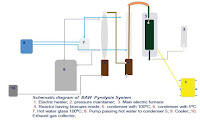Bio-oil is a complex mixture which contains a large number of organic compounds, including alcohol, organic acids, phenol, aldehyde, ketone, etc. Some of these chemicals, such as phenols are important industrial raw materials and additives. The total amount of phenolic compounds in the pyrolysis oil varies from 20.0% to 30% depending on the biomass used and operating conditions. Biooil contains several hundreds of chemicals as a result, it exhibits some inferior properties, such as high water content, high oxygen content, high viscosity low flash point, and strong corrosiveness. These drawbacks make it difficult to be directly used as a vehicle fuel.
Therefore, several upgrading technologies have been developed to improve the quality of bio-oil, including catalytic hydrodeoxygenation, catalytic cracking, steam reforming, catalytic esterification, supercritical upgrading and so on. Compared with phenols derived from petroleum fuel, these phenolic compounds are renewable and easily obtained. These phenols are not only used as a replacement for phenol in phenol–formaldehyde resins but also as raw materials for developing bio-based antioxidants and many other purposes. Pyrolysis offers the cheapest route to renewable liquid fuels. Nonetheless, many aspects of the pyrolysis pathway are still under investigation.

No comments:
Post a Comment